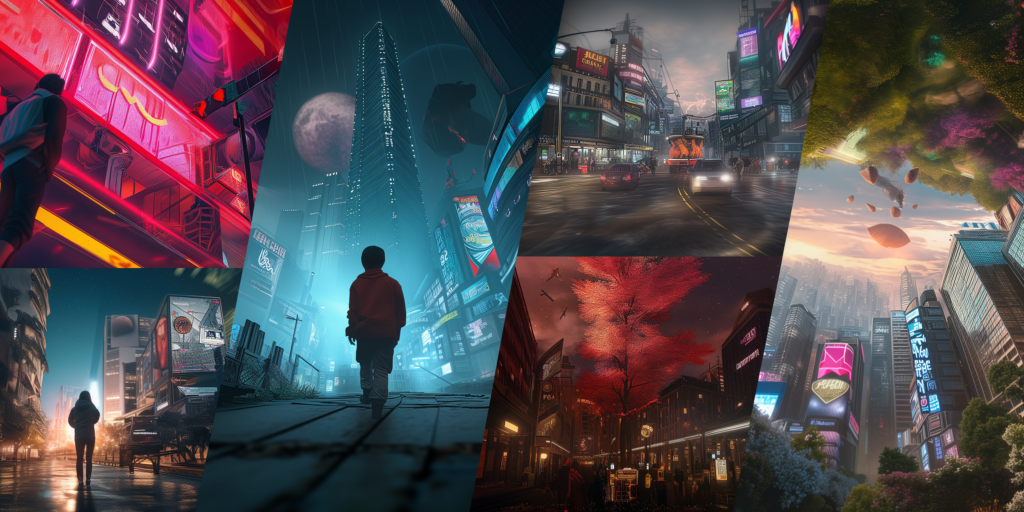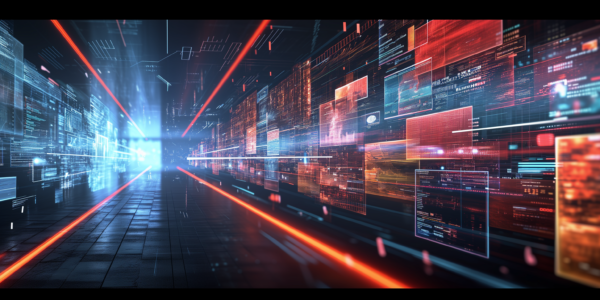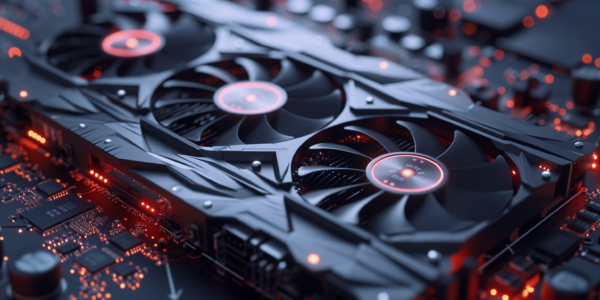
Professionals in 3D design, animation, and visual effects constantly seek ways to enhance their workflow and output quality. One game-changing technology that has impacted these industries is GPU rendering.
GPU rendering is a process that utilizes the capabilities of powerful dedicated graphics hardware to speed up the creation of images from 3D models. In this article, we will explain in detail what GPU rendering is. We will also offer perspectives into how 3D designers, architects, and other professionals can use it to their benefit, ensuring that projects are visually impressive and processed within tight deadlines.
What is GPU Rendering?
GPU rendering refers to using a Graphics Processing Unit (GPU) to render images, animations, or visual effects. Unlike conventional CPU rendering (which depends on the general-purpose cores of a computer’s central processing unit), graphics card rendering employs the parallel architecture of modern graphics cards to process vast amounts of data simultaneously.
This approach is especially well-suited for tasks that involve managing complex 3D scenes, high-resolution textures, and sophisticated lighting effects such as ray tracing, which can be computationally demanding.
Understanding the GPU’s Role
The GPU is a specialized electronic circuit designed to rapidly manipulate and change memory settings to accelerate the creation of images intended for output to a display. It excels in calculating the rendering of polygons, textures, and lighting in a scene, which makes it an irreplaceable tool for 3D artists and designers.
GPUs consist of thousands of cores, which operate in parallel to perform repetitive calculations involved in rendering. Such operations are pixel shading and geometry transformations. This parallel processing capability enables GPUs to meet the growing need for high-quality rendering.
It also supports advanced methods such as hardware ray tracing acceleration, which creates photorealistic effects by mimicking how light behaves in the real world.
GPU Rendering in Action
GPU rendering is not limited to a single industry. Still, it is a critical component across various sectors that require high-quality visual content.
In the gaming industry, it enables the real-time rendering of larger scenes, which allows for immersive gameplay experiences. In the film and animation industries, GPU rendering reduces rendering times and enables the faster production of complex visual effects.
Architects and interior designers benefit from GPU rendering by being able to visualize their projects with photorealistic lighting and materials, facilitating better design decisions and client presentations.
The common thread across all these applications is the need for faster rendering, high-quality visual output, and the ability to handle complex scenes efficiently.
GPU vs. CPU Rendering: In-depth Comparison
When it comes to rendering, the choice between using a GPU or CPU can significantly impact the efficiency and quality of the final output. Both have their advantages and are better suited for different types of tasks.
Understanding the differences between GPU and CPU rendering is crucial for professionals who need to make informed decisions about their hardware investments and workflow optimizations.
Comparing Processing Architecture
The fundamental difference between GPU and CPU rendering lies in their respective architectures. CPUs have fewer cores and lots of cache memory that can handle a small number of software threads at once.
In contrast, GPUs have thousands of smaller cores, far more in number, designed for handling multiple tasks simultaneously. This architectural distinction reveals GPUs are inherently better at handling the parallel processing demands of rendering, where you can process many calculations simultaneously.

For example, in rendering a scene, a GPU can work parallel on many pixels’ color, depth, and details. At the same time, a CPU would usually do this one after another. For this reason, GPUs are distinctively faster when computing in the artificial intelligence field.
Performance Metrics
Performance is a primary indicator in rendering, and the difference between using a GPU and a CPU is most apparent here. GPU rendering can significantly outdo CPU rendering in terms of speed, especially when handling scenes that utilize modern GPUs with features like Nvidia Optix, Nvidia Iray, or hardware ray tracing acceleration.
These technologies allow GPUs to render complex lighting and shadows more efficiently than CPUs. However, it’s crucial to observe that while GPUs excel in speed, they often are limited by GPU memory, which can be a bottleneck when working with large and complex scenes.
On the other hand, CPUs are generally more flexible regarding memory usage. Still, they may take more time to complete the same rendering tasks.
By understanding the capabilities and benefits of GPU rendering, professionals in the 3D design and animation fields can more effectively utilize this technology to produce superior-quality work. In the following sections, we will review the advantages of GPU rendering in detail, discuss the practicality of GPU render farms, and examine the technical aspects that contribute to its strength.
Advantages of Using GPU Rendering for Your Projects
GPU rendering provides many benefits that can improve the quality and productivity of projects in diverse sectors. By utilizing the strength of dedicated graphics hardware, you can attain quicker rendering times, enhanced performance, and increased consistency in your processes.
Below, we will provide further details on the matter.
Velocity
One of the strongest arguments for GPU rendering is that it boosts speed significantly. GPUs have multiple cores, often numbering in the thousands, allowing them to manage parallel tasks easily.
That is especially beneficial for rendering complex scenes where each pixel may need numerous calculations to determine its final color and texture. The ability to conduct these calculations simultaneously results in much quicker rendering times, enabling artists and designers to make changes faster and shorten the time from concept to final product.
This speed advantage is enhanced further by modern GPUs that feature technologies like Nvidia Optix and Nvidia Iray, optimized for rendering tasks.
Performance
GPUs have a clear advantage regarding rendering performance due to their architecture, which was developed with graphics computation in mind. This focus allows more efficient processing of rendering tasks, leading to increased frame rates and smoother previews.
This experience is crucial for video editing and animation, where real-time feedback is essential. Plus, you can boost GPU rendering performance by adding more GPUs. You can easily handle bigger or more complex scenes without an upgrade of the existing hardware setup.
Stability
Stability is a critical factor in long-duration rendering tasks, and GPU rendering excels also in this area. GPUs can handle continuous, heavy loads, which means they can sustain long rendering processes with less risk of crashes or interruptions.
This reliability is essential for meeting tight deadlines and ensuring that rendering processes do not hinder productivity. In addition to that, the stability of GPU rendering is ensured by ongoing updates in driver versions, which are regularly updated to address all potential issues and optimize performance.
Can You Use GPU-Based Render Farm for Rendering?
GPU-based render farms represent a game-changing solution for large-scale rendering projects.
These farms collect multiple GPUs to provide the required computational power for the most demanding rendering tasks. Learn more on that in the next section of our guide.

Benefits of GPU Render Farms
GPU render farms provide scalability that can adapt to the particular needs of a project. Whether working on an animated feature or complex simulations, render farms can save money and time by distributing the workload across multiple cloud GPU servers.
That speeds up the rendering process and makes handling motion blur, global illumination, and other intense effects more efficient. Moreover, GPU render farms can assist you in overcoming memory limitations that individual workstations might face when handling large datasets or high-resolution textures.
Choosing the Right GPU Render Farm
Choosing the right GPU render farm service is crucial to getting the most out of your rendering. Look for services that use strong Nvidia graphics cards, like the Nvidia Quadro RTX series, because they can handle real-time ray tracing and AI-enhanced workflows. This can significantly speed up rendering and improve quality.
Also, check if the render farm supports hardware ray tracing acceleration, the rendering software, and the plugins you use, and consider how fast data transfer is and its location since these factors can affect how efficiently it renders.
Exploring the Technical Aspects of GPU Rendering
Understanding the technical components that contribute to the effectiveness of GPU rendering is essential for professionals looking to optimize their rendering workflows.
This approach includes an in-depth look at the hardware capabilities, software compatibility, and optimization techniques that can enhance rendering performance.
Nvidia GPUs and Ray Tracing
Nvidia GPUs, particularly those in the Quadro RTX series, have brought real-time ray tracing to the forefront of rendering technology. Ray tracing is a technique that simulates the physical behavior of light, producing images with physically accurate shadows and global illumination.
Nvidia’s RTX GPUs, equipped with dedicated ray-tracing cores, offer hardware ray-tracing acceleration, speeding up this computationally intensive process. This advancement allows for creating more complex scenes with realistic shadows and lightning without the long rendering times that used to be typical.
Understanding GPU Memory and Limitations
While GPUs offer substantial benefits for rendering, it’s better to be aware of GPU memory limitations. The more GPU memory you have, the more complex scenes you can render efficiently.
Scenes with extensive geometry, high-resolution textures, and advanced effects may require significant memory. When the scene exceeds the GPU’s memory capacity, it can lead to slower rendering times or the need to simplify the scene, compromising the final quality.
Therefore, selecting a GPU with sufficient memory is crucial, and newer GPUs with larger memory capacities can provide more headroom for complex projects.
Software Compatibility and Optimization
The rendering software and drivers employed are just as crucial as the hardware. Using the latest driver version ensures the GPU works at its best and takes advantage of new improvements and features, like Nvidia Optix’s faster ray tracing. Software specifically crafted to utilize the capacities of powerful GPUs can lead to swifter performance and superior results.
For instance, rendering engines that support AI denoising can employ the tensor cores found in modern GPUs to diminish noise in rendered images, thereby enhancing quality without extending rendering times.
Exploring the technical aspects of GPU rendering, we see how the right combination of hardware and software improves the rendering workflows. By understanding the capabilities and limitations of GPU memory, the benefits of hardware ray tracing acceleration, and the importance of software compatibility, professionals can make informed decisions that will enhance their rendering performance and ultimately lead to better project outcomes.
Real-World Applications and Case Studies
GPU rendering is not just a theoretical advancement; it has practical, real-world applications that have transformed the workflows of many professionals in the 3D design and animation industries.
These case studies and examples show the real benefits of GPU rendering usage.
Video Editing and Motion Graphics
GPU rendering has been a game-changer in video editing and motion graphics. Thanks to the GPUs’ faster performance, editors and animators can now operate with higher frame rates and achieve real-time feedback on their edits.
This immediate responsiveness is essential for fine-tuning motion blur and other dynamic effects, ensuring that the final product matches the creator’s vision. Furthermore, powerful GPUs like the Nvidia Quadro RTX series permit more complex effects to be rendered in less time, making the creative process more seamless and less restricted by technical limitations.
Architectural Visualization and Complex Scenes
Architectural visualization is another area where GPU rendering excels. Architects and designers can create more detailed and complex scenes with textures, geometry, and lighting that were once too resource-heavy to render promptly.
The capacity to render these components swiftly and with accurate shadows makes the visuals more realistic, helping clients fully grasp the design. The consistency and performance of GPU rendering also imply that last-minute modifications can be included and visualized without substantial delays, enabling changes and a cooperative design process.
Conclusion: Harnessing the Power of GPU Rendering
GPU rendering is a powerful tool that can transform how professionals in 3D design, animation, and other computationally intensive fields work. By understanding the advantages and technical aspects of GPU rendering, professionals can make informed decisions that will benefit their projects and workflows.
As we have explored, GPU rendering offers speed, performance, and stability that can significantly enhance the rendering process. By staying informed about the latest advancements in GPU technology and rendering software, you can continue to push the boundaries of what is possible in your work.
Are you looking to use GPU rendering? Here’s what you can do next: check your hardware, explore GPU render farms, and stay updated on software developments. This way, you can make the most of GPU rendering for your projects.
Sources:
- Nvidia Quadro RTX
- Nvidia Optix
- Nvidia Iray
- TechPowerUp GPU Specs
- CG Architect
- Blender
- Autodesk 3D Rendering
- Chaos Group
- Unreal Engine
- Redshift 3D
- Maxon Red Giant
- Adobe After Effects
- SideFX Houdini
- OTOY
- Cinema 4D
Frequently Asked Questions:
-
Can GPU Rendering Fully Replace CPU Rendering?
While GPU rendering is superior in speed and performance for many tasks, it may not fully replace CPU rendering due to the flexibility and precision CPUs offer for certain complex scenes.
-
Why the Most High-End GPU is Not Always the Most Efficient in GPU Rendering?
The high-end GPU may not be the most efficient for all rendering tasks. Efficiency depends on project requirements, software optimization, and the balance between power and performance.
-
How Does GPU Rendering Affect Workflow Efficiency?
GPU rendering enhances workflow efficiency by reducing rendering times, enabling more iterations, and providing real-time previews, leading to a more dynamic creative process.
-
What Should You Consider When Upgrading Your GPU for Rendering?
Consider the types of projects you handle, rendering software compatibility, GPU memory capacity, and the cost-performance balance when upgrading your GPU for rendering.
